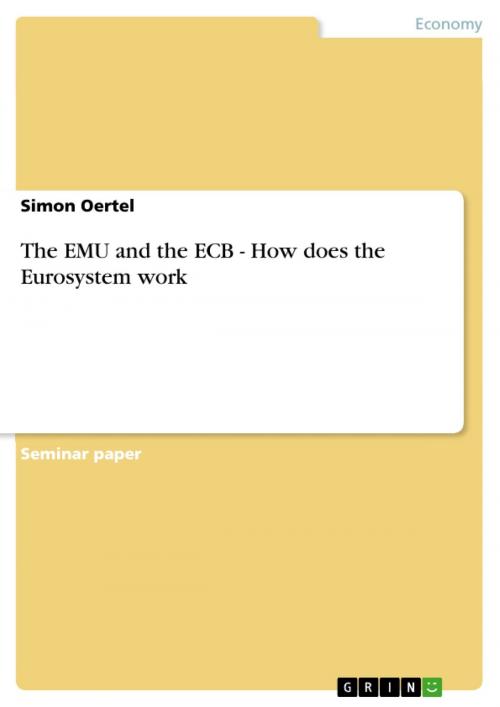The EMU and the ECB - How does the Eurosystem work
How does the Eurosystem work
Business & Finance, Economics, Money & Monetary Policy| Author: | Simon Oertel | ISBN: | 9783638591553 |
| Publisher: | GRIN Publishing | Publication: | January 12, 2007 |
| Imprint: | GRIN Publishing | Language: | English |
| Author: | Simon Oertel |
| ISBN: | 9783638591553 |
| Publisher: | GRIN Publishing |
| Publication: | January 12, 2007 |
| Imprint: | GRIN Publishing |
| Language: | English |
Seminar paper from the year 2005 in the subject Economics - Monetary theory and policy, grade: A, Washington College (Faculty of Economics), course: International Finance 401, 5 entries in the bibliography, language: English, abstract: The creation of the European Monetary Union (EMU) and the introduction of the euro has been an experiment without comparable predecessor. The euro area combined has the second largest GDP in the world, only outperformed by the United States. Therefore, this historical event has been widely discussed, in different academic fields (economics, sociology, history, psychology and others), in different countries, and of course bars, newspapers and TV shows all around the world. As with probably every event of this impact, the opinions on whether the euro is a success or not are widely spread. This paper tries to give a brief overview on two major topics: the Stability and Growth Pact which sets the rules for the countries participating in EMU and the European Central Bank, the newly created institution which is set up to guard the price stability in the euro area and the confidence in the euro. The paper will first give an historical overview on the events that led to the creation of EMU, then, it introduces the Stability and Growth Pact (SGP) and the Maastricht Criteria. The field of economics is divided between supporters and opponents of the SGP therefore, their different points of view will be presented. Thereafter, the recent developments in the euro area will be discussed. The second part will present the ECB, the system it operates in and its functions. In order to include international financial theory, I briefly discuss the ECB's monetary policy and its influence on inflation. Last but not least, a conclusion will present arguments for and against a successful euro, and also present my personal point of view. [...]
Seminar paper from the year 2005 in the subject Economics - Monetary theory and policy, grade: A, Washington College (Faculty of Economics), course: International Finance 401, 5 entries in the bibliography, language: English, abstract: The creation of the European Monetary Union (EMU) and the introduction of the euro has been an experiment without comparable predecessor. The euro area combined has the second largest GDP in the world, only outperformed by the United States. Therefore, this historical event has been widely discussed, in different academic fields (economics, sociology, history, psychology and others), in different countries, and of course bars, newspapers and TV shows all around the world. As with probably every event of this impact, the opinions on whether the euro is a success or not are widely spread. This paper tries to give a brief overview on two major topics: the Stability and Growth Pact which sets the rules for the countries participating in EMU and the European Central Bank, the newly created institution which is set up to guard the price stability in the euro area and the confidence in the euro. The paper will first give an historical overview on the events that led to the creation of EMU, then, it introduces the Stability and Growth Pact (SGP) and the Maastricht Criteria. The field of economics is divided between supporters and opponents of the SGP therefore, their different points of view will be presented. Thereafter, the recent developments in the euro area will be discussed. The second part will present the ECB, the system it operates in and its functions. In order to include international financial theory, I briefly discuss the ECB's monetary policy and its influence on inflation. Last but not least, a conclusion will present arguments for and against a successful euro, and also present my personal point of view. [...]















